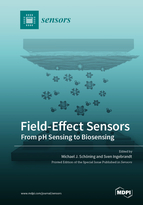Field-Effect Sensors: From pH Sensing to Biosensing
A special issue of Sensors (ISSN 1424-8220). This special issue belongs to the section "Biosensors".
Deadline for manuscript submissions: closed (31 May 2022) | Viewed by 31566
Special Issue Editors
Interests: silicon-based chemical sensors and biosensors; field-effect devices; thin film and semiconductor techniques; micro- and nanosystem technology
Special Issues, Collections and Topics in MDPI journals
Interests: biosensors; bioelectronics; field-effect transistors; nanowires; graphene; wearables; micro- and nanosystems
Special Issue Information
Dear Colleagues,
The groundbreaking Short Communication by Piet Bergveld in 1970 (“Development of an ion-sensitive solid-date device for neurophysiological measurements”, IEEE Trans. on Biomed. Eng.) has stimulated and attracted a multitude of (young) scientists within the last five decades working with ion-sensitive field-effect devices for chemical sensing and biosensing, distinctly enhancing the device structures, materials, (bio)receptor layers, electronic amplifier circuits, system integration, and sensor performance as well as broadening the areas of applications. Mainly, three types of (bio-)chemical field-effect sensors are discussed in literature, i.e., ISFETs (ion-sensitive field-effect transistors), most of the time called nanowire devices in nanometer dimensions, LAPS (light-addressable potentiometric sensors), and capacitive EIS (electrolyte–insulator–semiconductor) sensors. This Special Issue is devoted to the different types of field-effect devices and to the scopes of their applications, compiling examples of state-of-the-art technologies. The topic may include but is not exclusively related to:
- Device concepts for field-effect sensors for (bio-)chemical sensing;
- Modelling and theory of field-effect sensors;
- Nanomaterial-modified field-effect (bio-)chemical sensors;
- Field-effect sensors for biomedical analysis, food control, and environmental monitoring;
- Field-effect sensors for recording of neuronal and cell-based signals;
- Chemical imaging with field-effect sensors
Prof. Dr. Michael J. Schöning
Prof. Dr. Sven Ingebrandt
Guest Editors
Manuscript Submission Information
Manuscripts should be submitted online at www.mdpi.com by registering and logging in to this website. Once you are registered, click here to go to the submission form. Manuscripts can be submitted until the deadline. All submissions that pass pre-check are peer-reviewed. Accepted papers will be published continuously in the journal (as soon as accepted) and will be listed together on the special issue website. Research articles, review articles as well as short communications are invited. For planned papers, a title and short abstract (about 100 words) can be sent to the Editorial Office for announcement on this website.
Submitted manuscripts should not have been published previously, nor be under consideration for publication elsewhere (except conference proceedings papers). All manuscripts are thoroughly refereed through a single-blind peer-review process. A guide for authors and other relevant information for submission of manuscripts is available on the Instructions for Authors page. Sensors is an international peer-reviewed open access semimonthly journal published by MDPI.
Please visit the Instructions for Authors page before submitting a manuscript. The Article Processing Charge (APC) for publication in this open access journal is 2600 CHF (Swiss Francs). Submitted papers should be well formatted and use good English. Authors may use MDPI's English editing service prior to publication or during author revisions.








